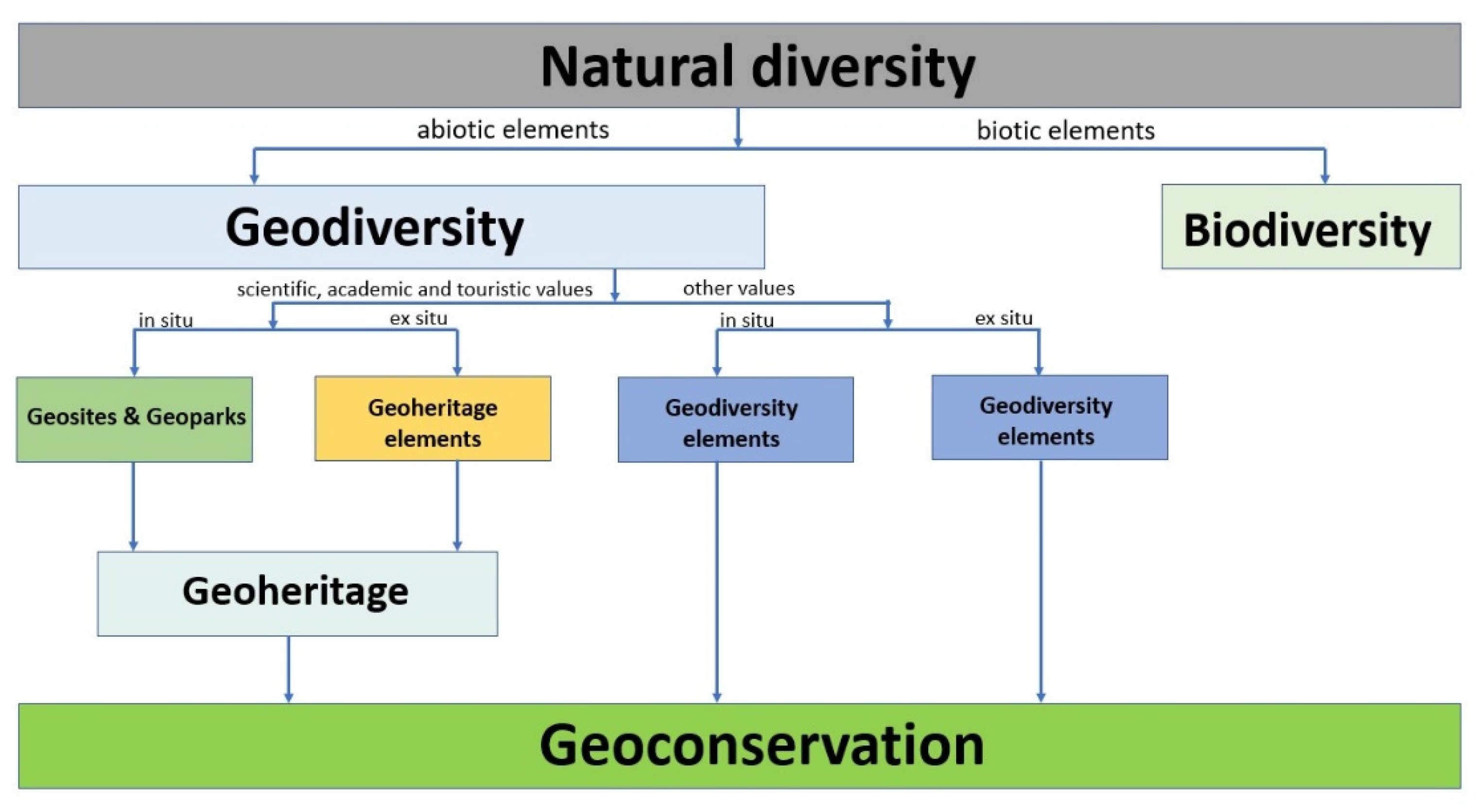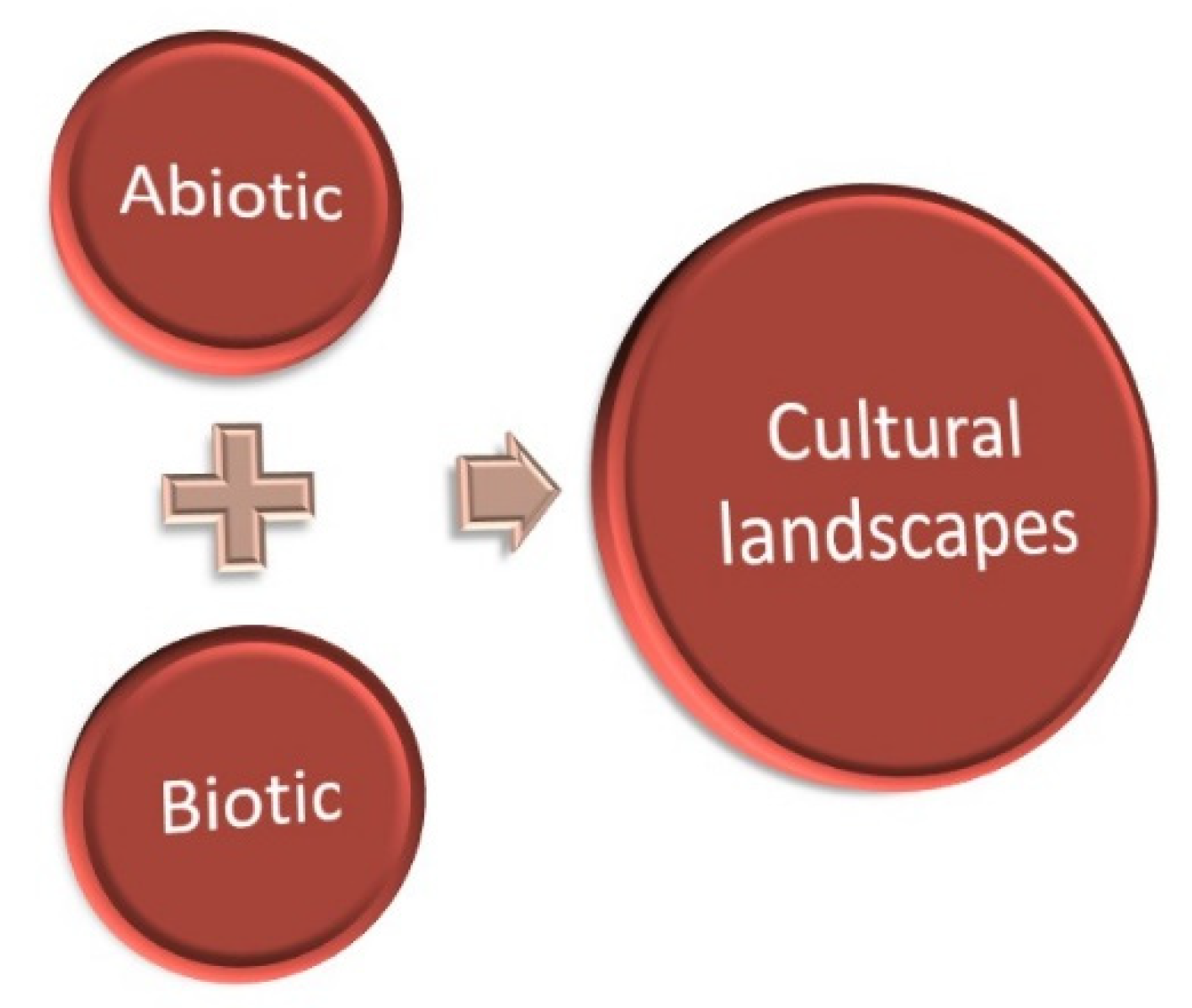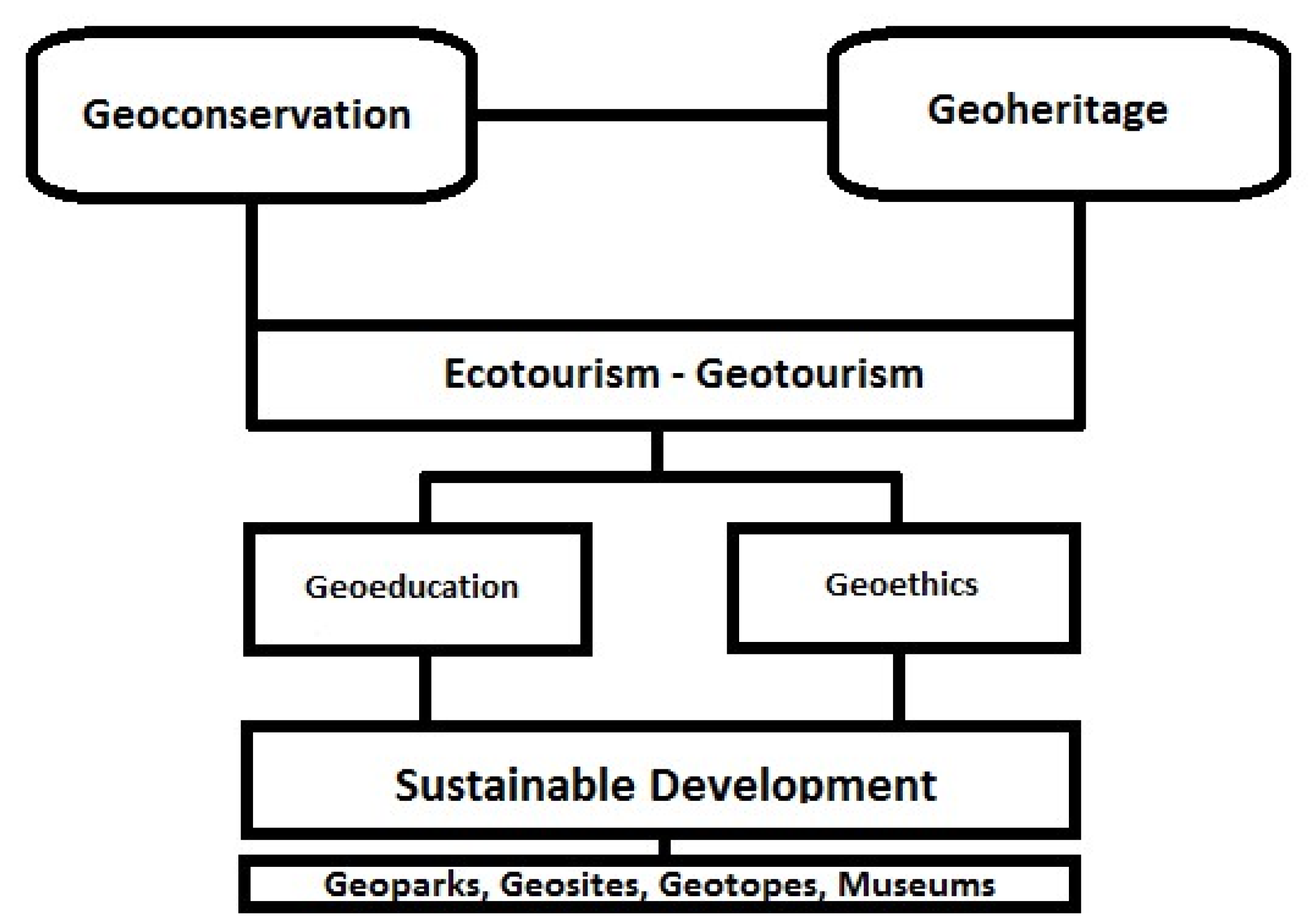
| Version | Summary | Created by | Modification | Content Size | Created at | Operation |
|---|---|---|---|---|---|---|
| 1 | Hara Drinia | + 2515 word(s) | 2515 | 2021-09-13 06:26:36 |
Video Upload Options
“Geoheritage” is a new term that assumes complete perception of Man for nature and the environment. As stated by McBriar “Geological-geomorphological heritage is the collection of geotopes, deposits, forms, and processes that comprise the geological history of each region, and the concept of preserving geological-geomorphological heritage is a cultural concept”.
1. Introduction
In the last few decades and under the UNESCO (United Nations Educational Scientific and Cultural Organization) initiative, there has been an increasing attempt to establish environmental education and its framework in various ways. More precisely, a meeting in Belgrade (Serbia) in 1976, under the auspices of UNESCO, formalized a set of documents known as Charter of Statutes of Belgrade [1], explicitly mentions the need for a significant change in human attitudes by taking more effective action for the global environmental issue through universal effort at school units. As a result of this effort, a strategy has been established that will allow some organizations and individuals to present more systematic content on environmental challenges and how to address them. In this way, a more harmonious balance between environment and human activity could be reached. This has resulted in several environmental programs in schools, with the goal of rationalizing future citizens to assist them in adopting a more positive attitude toward the needs of our planet and our society, after having received appropriate and necessary knowledge of such matters in advance.
It is worth mentioning that UNESCO never gave up on the idea and initiative of the environmental education; in fact, in 1977 [2], in the context of the International Conference in Tbilisi (Georgia), the participants agreed that environmental education should be treated as a distinct scientific field of paramount importance that should be integrated into educational programs rather than being treated as an afterthought.
Along with environmental education, an international effort was launched to establish and protect the geological heritage. In 1972, the Convention on the Protection of the World Cultural and Natural Heritage took place in Paris (France), and some years later, in 1991, the International Declaration on the Rights of the Memory of the Earth took place in Digne (France) [3]. Through these conferences and their declarations, a European initiative for the protection of geoheritage and geoconservation was launched, with the goal of protecting exceptional geological areas that reflect the evolution of biotic and abiotic factors. In 2000, the European Geoparks Network (EGN) was founded to promote a more systematic and collective process of development and, of course, to ensure geodiversity [4]. Following this, in 2004, the Global Geoparks Network was established, which, along with the EGN, aims to promote the concept of geological heritage in the scientific community and the public, as well as to promote sustainable development in areas that host the geoparks [5].
Despite these initiatives to promote and protect the geological heritage, environmental education does not deepen directly into issues related to geoethics, geodiversity, and geoheritage. There is a reasonable need to promote geoeducation, which will deal exclusively with the above concepts and will be the primary tool for the first transmission of knowledge and highlighting the importance of places of intense geological interest, which, in turn, will offer the opportunity of geotourism services [6]. Specifically, geotourism encourages various forms of geoeducation in order to organize geosites to be open for the public and offering educational and recreational activities [7][8].
Finally, the need for a more rational assessment of the geoenvironmental status of our planet, as well as the need for more effective management of issues connected to geoenvironmental conservation, led to the development of a new field of geosciences: Geoethics. The first function of geoethics is to improve the social profile and role of geoscience. Moreover, it contributes to forwarding the sustainable use of natural sources with harmonious operation between human activity and environment. Consequently, this field can accelerate strategies and methods that will respect geoheritage and its prospective [9].
2. From Geoheritage to Geoeducation, Geoethics and Geotourism
2.1. Geoheritage and Geoconservation

Figure 1. Conceptual framework of geodiversity, geological heritage, and geoconservation. Modified from [20].
2.2. The Need for More Systematic Use of Geoeducation and its Awareness
2.3. The Positive Impact of Geotourism

2.4. Geoethics

References
- UNESCO—U.N. Environment program. In Proceedings of the International Workshop on Environmental Education at Belgrade, Belgrade, Yugoslavia, 13–22 October 1975; pp. 1–4.
- UNESCO. In Proceedings of the Intergovernmental Conference Education, Tbilisi, Georgia, 14–26 October 1977; UNESCO: Paris, France, 1978; pp. 1–96.
- Martini, G. (Ed.) Actes du Premier Symposium International sur la Protection au Patrimonie Geologique. In Proceedings of the First Symposium on Earth Heritage Conservation, Digne, France, 11–16 June 1991; Memoires de la Societe geologique de France; Société géologique de France: Paris, France, 1993; Numero Special 165; p. 276.
- Zouros, N. The European Geoparks Network. Episodes 2004, 27, 165–171.
- Zouros, N.; Martini, G. Introduction to the European Geoparks Network. In Proceedings of the 2nd European Geoparks Network Meeting: Lesvos, Natural History Museum of the Lesvos Petrified Forest, Lesvos, Greece, 3–7 October 2003; Zouros, N., Martini, G., Frey, M.-L., Eds.; pp. 17–21.
- Farsani, N.D.; Coelho, C.; Costa, C. Geotourism and Geoparks as novel strategies for socio-economic development in rural areas. Int. J. Tour. Res. 2011, 13, 68–81.
- Dowling, R.; Newsome, D. (Eds.) Geotourism; Elsevier/Heineman: Oxford, UK, 2006.
- Hose, T. A3G’s for Modern. Geotourism. Geoheritage 2012, 4, 7–24.
- Vascanelos, C.; Moutinho, S.; Torres, J. Geothics in the context of Sustainability and its Teaching across the Curriculum. In Proceedings of the 8th International Conference of Education, Research and Innovation, Seville, Spain, 16–18 November 2015.
- Gordon, J.E. Geoheritage, Geotourism and the Cultural Landscape: Enhancing the Visitor Experience and Promoting Geoconservation. Geosciences 2018, 8, 136.
- McBriar, M. Foreword. In A Report Prepared for the Australian Heritage Commission by the Standing Committee for the Geological Heritage of the Geological Society of Australia Inc.; Joyce, E.B., Ed.; Standing Committee for Geological Heritage of the Geological Society of Australia Inc.: Sydney, Australia, 1995.
- UNESCO. UNESCO Geoparks Programme—A New Initiative to Promote a Global Network of Geoparks Safeguarding and Developing Selected Areas Having Significant Geological Features; Document 156 EX/11 Rev., Executive Board, 156th session; UNESCO: Paris, France, 1999; p. 4.
- European Manifesto on Earth Heritage and Geodiversity. 2004. Available online: http://www.progeo.pt/pdfs/Manifesto_EH.pdf (accessed on 9 May 2021).
- Gray, M. Geodiversity: Valuing and Conserving Abiotic Nature; John Wiley: Chichester, UK, 2004.
- Sharples, C.; Concepts and Principles of Geoconservation. Tasmanian Parks and Wildlife Service. 2002. Available online: http://www.dpipwe.tas.gov.au/Documents/geoconservation.pdf (accessed on 3 July 2021).
- Brocx, M.; Semeniuk, V. Geoheritgae and geoconservation—History, definition, scope and scale. J. R. Soc. West. Aust. 2007, 90, 53–87.
- Semeniuk, V. The linkage between biodiversity and geodiversity. In Pattern and Process—Towards a Regional Approach to National Estate Assessment of Geodiversity; Canberra ACT: Environment Australia Technical Series No 2; Eberhard, R., Ed.; Australian Heritage Commission: Canberra, Australia, 1996; pp. 51–58.
- Semeniuk, V.; Semeniuk, C.A. Human impacts on globally to regionally significant geoheritage features of the Swan Coastal Plain and adjoining coastal zone, southwestern Australia. In Gondwana to Greenhouse: Australian Environmental Geoscience; Gostin, V.A., Ed.; Geological Society of Australia: Sydney, Australia, 2001; pp. 181–199.
- Prosser, C.D.; Bridgland, D.R.; Brown, E.J.; Larwood, J.G. Geoconservation for science and society: Challenges and opportunities. Proc. Geol. Assoc. 2011, 122, 337–342.
- Lazzari, M. Geosites, cultural tourism and sustainability in Gargano National park (southern Italy): The case of the Salata (Vieste) geoarchaeological site. Rend. Online Soc. Geol. It. 2013, 28, 97–101.
- Mc Keever, P.; Zouros, N. Geoparks: Celebrating earth heritage, sustaining local communities. Episodes 2005, 28, 274–278.
- EGN. European Geoparks Magazine No 7. 2005, p. 36. Available online: http://www.europeangeoparks.org (accessed on 9 May 2021).
- UNESCO. Transforming our World: The 2030 Agenda for Sustainable Development. 2005. Available online: https://sustainabledevelopment.un.org/content/documents/21252030%20Agenda%20for%20Sustainable%20Development%20web.pdf (accessed on 9 May 2021).
- Herrera-Franco, G.; Montalván-Burbano, N.; Carrión-Mero, P.; Apolo-Masache, B.; Jaya-Montalvo, M. Research trends in geotourism: A bibliometric analysis using the scopus database. Geosciences 2020, 10, 379.
- Robinson, A.M. Geotourism: Who is a geotourist. In Proceedings of the Inaugural National Conference on Green Travel, Climate Change and Ecotourism, Adelaide, Australia, 17–20 November 2008; pp. 909–923.
- Farsani, N.T.; Coelho, C.; Costa, C. Rural geotourism: A new tourism product. Acta Geoturistica 2013, 4, 1–10.
- Joyce, E.B. Geological heritage of Australia: Selecting the best for Geosites and World Heritage and telling the story for geotourism and Geoparks. ASEG Ext. Abstr. 2006, 2006, 1–4.
- Kanellopoulou, G. The challenge of geotourism in Greece: Geocultural routes in Zagori region (NW Greece). In Proceedings of the IMIC, 1st International Conference on Experiential Tourism, Santorini, Greece, 9–11 October 2015; pp. 9–11.
- Dowling, R.K. Global geotourism—An emerging form of sustainable tourism. Czech J. Tour. 2013, 2, 59–79.
- Peppoloni, S.; Di Capua, G. The meaning of geoethics. In Ethical Challenges and Case Studies in Earth Sciences; Wyss, M., Peppoloni, S., Eds.; Elsevier: Amsterdam, The Netherlands, 2015; pp. 3–14.
- Brocx, M.; Semeniuk, V. The ‘8Gs’—A blueprint for Geoheritage, Geoconservation, Geo-education and Geotourism. Aust. J. Earth Sci. 2019, 66, 803–821.
- Chan, K.M.; Balvanera, P.; Benessaiah, K.; Chapman, M.; Díaz, S.; Gómez-Baggethun, E. Luck GW Opinion: Why protect nature? Rethinking values and the environment. Proc. Natl. Acad. Sci. USA 2016, 113, 1462–1465.
- Slaymaker, O.; Spencer, T.; Embleton-Hamann, C. Geomorphology and Global Environmental Change; Cambridge University Press: Cambridge, UK, 2015.
- Winter, C. The intrinsic, instrumental and spiritual values of natural area visitors and the general public: A comparative study. J. Sustain. Tour. 2007, 15, 599–614.
- Papayannis, T.; Howard, P. Editorial: Nature as Heritage. Int. J. Herit. Stud. 2007, 13, 298–307.
- Vucetich, J.; Bruskotter, J.; Nelson, M. Evaluating whether nature’s intrinsic value is an axiom of or anathema to conservation. Conserv. Biol. 2015, 29, 321–332.
- Drinia, H.; Tsipra, T.; Panagiaris, G.; Patsoules, M.; Papantoniou, C.; Magganas, A. Geological heritage of syros island, cyclades complex, Greece: An assessment and geotourism perspectives. Geoscience 2021, 11, 138.




